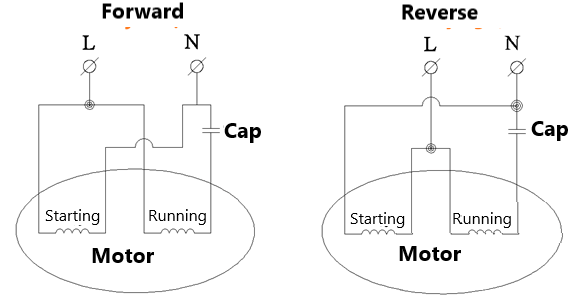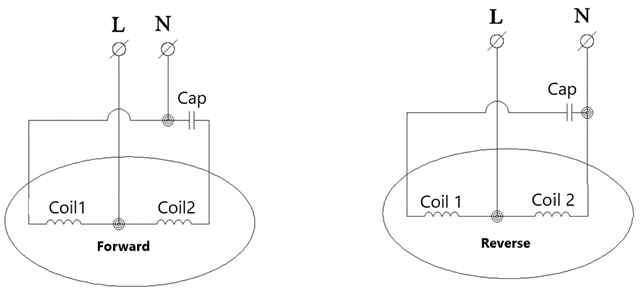Learn about the principle of reversing single phase motor. Firstly, we will talk about the structure and working principle of a single phase motor.
1. Structure and working principle
+ Structure: The stator of single phase motor has only one winding, the rotor is usually a squirrel cage rotor. When the motor is running, the stator winding will be connected to single-phase AC power.
+ Working principle: When alternating current flows into the stator winding, it will not create a rotating magnetic field. Due to the variation of current, the direction and value of the magnetic field change, but the direction of the magnetic field is fixed in space. This magnetic field is called the pulse magnetic field.
=> So we need a method to start a single phase motor.
+ Advantages and disadvantages of single phase motor
The advantage of a single-phase electric motor is that it is simple and cheaper than three phase motor. Therefore, it is used in devices such as fans, washing machines, water pumps and is used a lot in automatic systems.
The disadvantages of single phase motors are low cosφ, large rotor losses, small torque, and poor overload capacity.
2. Single phase motor starting
When we supply power to a single-phase asynchronous motor, the motor cannot rotate by itself. We can use force to make the motor rotate in a certain direction. The rotor will then continue to rotate in that direction.
The commonly used method for self-starting single-phase motors is to use an auxiliary winding or a short circuit at the magnetic pole.
+ Using an auxiliary winding
For motors using auxiliary windings, in addition to the main winding, there are also auxiliary windings, also known as starter windings. Auxiliary windings can be made designed for long-term operation with single-phase motors or only at start-up. The coil working only at start-up will be disconnected from the motor, after the motor has finished starting.

Starting single phase motor with an auxiliary winding
The auxiliary winding will be placed in the stator slot to generate a flux. This flux will deviate at an angle of 90 degrees in space from the flux produced by the main coil.
And between the current in the main coil and the current in the auxiliary coil need to be out of phase by 90 degrees. To do this, we will connect the auxiliary coil to the capacitor C.
The current in the auxiliary winding and main winding will generate a rotating magnetic field, thereby creating the torque to start the AC motor. The type of motor with the addition of a capacitor will have good starting characteristics.
+ The motor has a short circuit at the magnetic pole
In this motor, people will split the magnetic pole and add a short circuit. The short-circuit loop acts as an auxiliary winding.
When the motor is energized, the magnetic fields of the main and auxiliary windings create a rotating magnetic field. The motor therefore generates the torque to start the motor.
This type of motor is used in automatic transmission, most commonly a small table fan. Because the motor is only suitable for small capacity 0.5 – 30W.
3. Reversing single phase motor
To reverse the rotation of a single-phase motor, we need to change the direction of the rotating magnetic field generated by the main and starter windings. There are two types of single-phase motors: 4-wire and 3-wire. For each type of motor, we will have a different way to reverse the direction:
+ Reversing 4-wire motor
This type of motor will have two separate windings, each with two output wires. We can determine the main and auxiliary windings by measuring the resistance of each winding. The coil with higher resistance is the auxiliary (starting) coil, the lower resistance coil is the main (running) coil.
To reverse this motor we will reverse one of the two windings running or starting. The figure below shows how to reverse 4-wire motor by reversing the main coil.

Reversing 4-wire single phase motor
+ Reversing 3-wire motor
3-wire motors still have two windings, but inside the motor, the starter and running coils are connected into a common wire. Therefore, the 3 output wires will be the starter wire, the common wire and the running wire.
We reverse the motor direction by changing the connection of the capacitor. Specifically, the figure below shows that when running forward, the capacitor is in series with coil 2. When the motor runs in reverse, the capacitor is in series with coil 1.

Reversing 3-wire single phase motor
Refer to the video about Reversing single phase induction motors – Matthias Wandel
>>> See also:
What is contactor? The best article about contactor
Working principle of star delta starter circuit (4 circuits)
Three phase rectifier circuit using diodes and scr (8 diagrams)